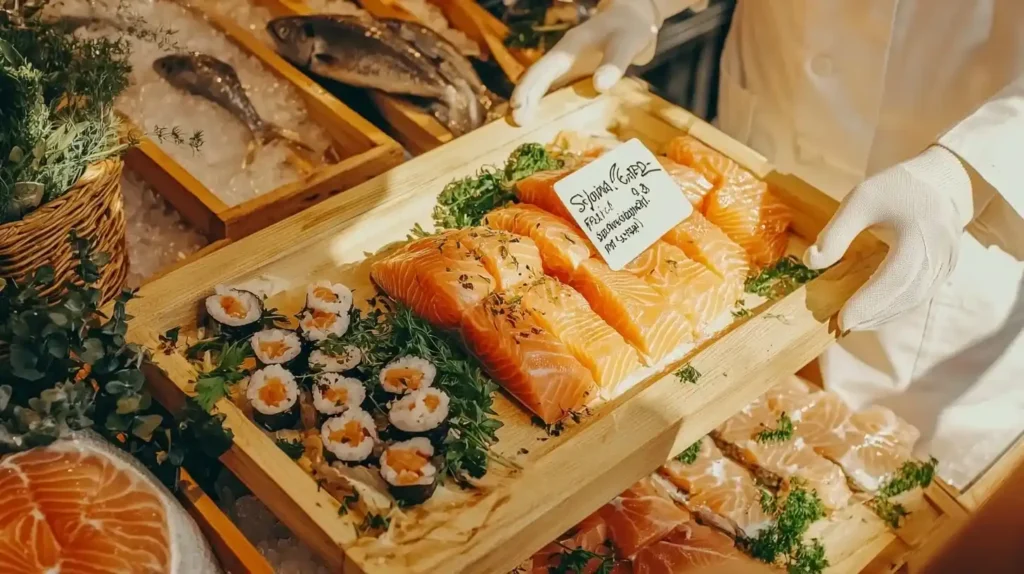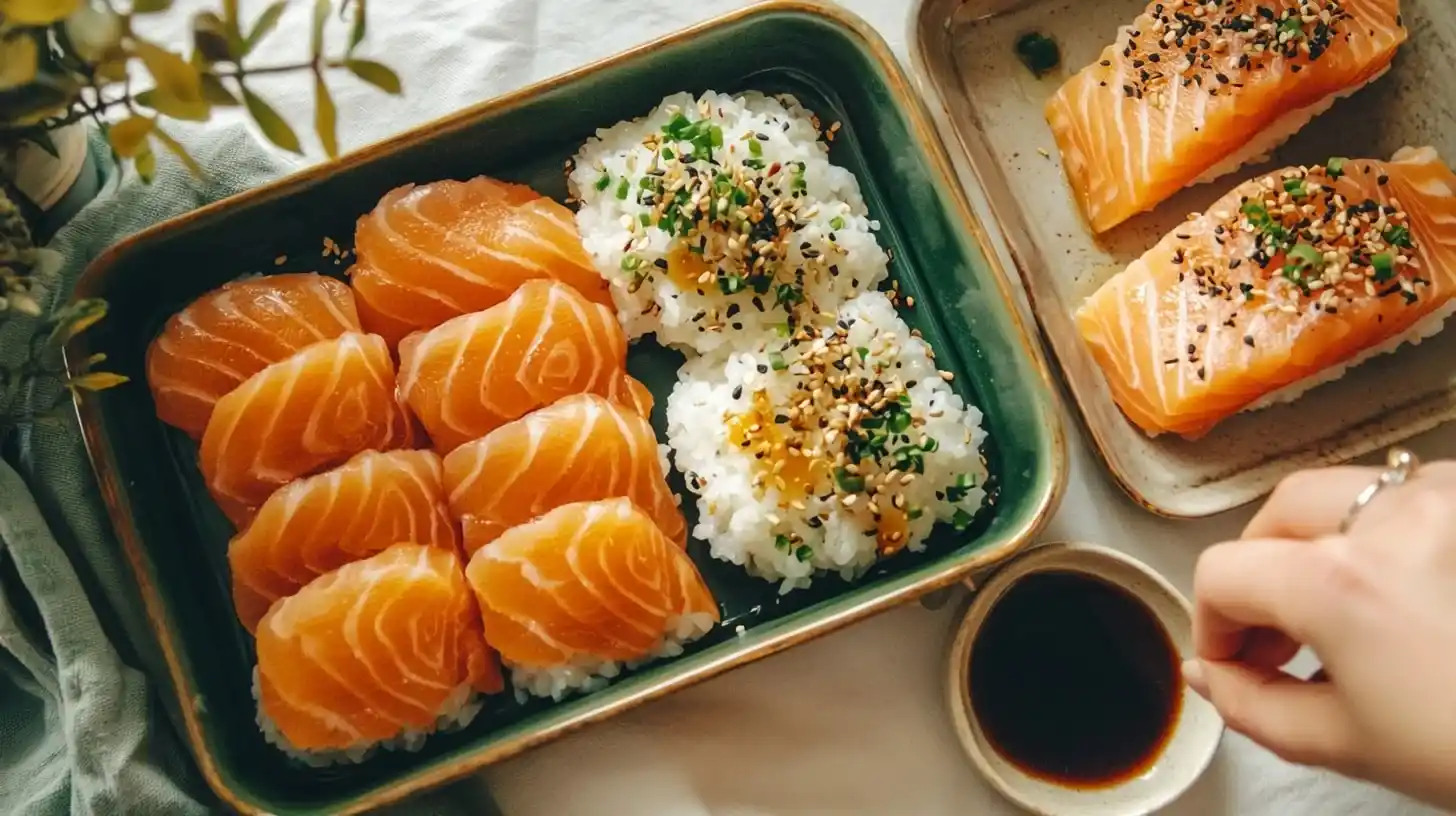“But isn’t raw fish dangerous?” My mother-in-law’s concerned question as I served homemade Salmon Nigiri at our family gathering reflected a common worry many have about this elegant Japanese dish.Is Salmon Nigiri Raw?.
The simple answer is yes – traditional salmon nigiri features raw salmon on vinegared rice. However, this straightforward answer comes with important nuances about safety, preparation options, and quality considerations that determine whether serving raw salmon at home is appropriate.
My journey into home Japanese cooking began cautiously, with significant research about safe raw fish preparation before I felt comfortable serving it to my family. What I discovered changed both my understanding and confidence in preparing this delicacy.
Table of Contents
Traditional Salmon Nigiri: Raw by Definition

Is Salmon Nigiri Raw?. Show Main Image Traditional raw salmon nigiri (left) versus the partially seared option (right) – both delicious preparations with different safety considerations!
Authentic, traditional salmon nigiri is indeed raw fish served on seasoned rice.
In Japanese restaurants, the salmon used is specifically selected, handled, and prepared with raw consumption in mind.
The freshness and quality of the fish is paramount, with proper handling throughout the supply chain to maintain food safety.
For those confused about various Japanese fish preparations, What is nigiri vs sashimi? clarifies that both traditionally feature raw fish, with the difference being that nigiri includes rice while sashimi is just the fish.
The characteristic flavor and texture that makes salmon nigiri so prized comes from the raw state of the fish. Many wonder What does salmon nigiri taste like? – the answer involves a delicate, buttery mouthfeel and subtle ocean freshness that cooking would fundamentally alter.
For more globally-inspired recipes including Japanese cuisine, explore our International Lunch Inspirations: Global Flavors Made Simple collection, which features accessible international dishes for family meals.
Safe Raw Salmon: What to Look For
Show Fish Market Image Shopping for salmon nigiri starts with finding properly labeled ‘sushi-grade’ fish from a reputable source – the most critical step for safe preparation!
Not all salmon is appropriate for raw consumption – this is the most critical safety point to understand.
Look specifically for fish labeled “sushi-grade” or “sashimi-grade,” which indicates it’s been handled appropriately for raw consumption.
These designations, while not legally regulated in all locations, generally indicate the fish has been frozen to specific temperatures to kill potential parasites.
Most reputable fishmongers follow FDA guidelines requiring fish for raw consumption to be frozen at -4°F (-20°C) for a minimum of 7 days, or flash-frozen at -31°F (-35°C) for 15 hours.
My first purchase of sushi-grade salmon involved a detailed conversation with our local fishmonger, who explained their freezing protocols and handling practices.
Relationship with your fish provider matters – a trustworthy source will answer questions about their handling practices and freezing procedures.
Fish markets serving Japanese or Asian communities often have the best selection of appropriate raw fish, as they regularly supply customers preparing raw fish dishes.
For comprehensive meal ideas beyond Japanese cuisine, our Family-Friendly Lunch Recipes: Effortless Meals for Busy Parents collection offers additional inspiration for busy families.
Salmon Nigiri Alternatives with Cooked Fish
For those uncomfortable with raw fish, several delicious alternatives exist:
Aburi Salmon: This preparation features salmon that’s partially seared with a kitchen torch, creating a thin cooked outer layer while maintaining a tender center.
Fully Cooked Salmon: Nigiri can be prepared with thinly-sliced poached or baked salmon for those who prefer fully-cooked fish.
Smoked Salmon: Using cold-smoked salmon creates a flavor-packed alternative to raw while maintaining a similar texture.
My grandmother never expected to enjoy Japanese cuisine in her Kentucky home, but she happily tried my torch-seared salmon nigiri, declaring it “the perfect middle ground between raw and cooked.”
These alternatives still deliver the essence of the nigiri experience while addressing safety concerns for young children, pregnant women, elderly, or immunocompromised individuals.
Raw Fish Safety at Home
Several practices maximize safety when preparing raw fish:
Keep everything impeccably clean – dedicated cutting boards and knives for raw fish are ideal.
Maintain proper temperature control – keep fish refrigerated until just before preparation and serve immediately.
Practice excellent hand hygiene throughout preparation.
My husband initially expressed concern about serving raw fish to our children. Through research, we learned that healthy children past age 5 can generally enjoy properly sourced raw fish in moderation.
For those interested in nutritional aspects, Is salmon nigiri healthy for you? examines how this preparation preserves salmon’s impressive nutritional profile, including omega-3 fatty acids and high-quality protein.
Answers to Your Raw Salmon Questions
Can I use salmon from the regular grocery seafood counter for nigiri? No – standard supermarket fish isn’t handled with raw consumption in mind. My first attempt at home nigiri involved a special trip to a Japanese market 45 minutes away, but the quality difference justified the journey.
What about frozen salmon from grocery stores? Standard frozen salmon isn’t appropriate for raw consumption. The freezing process for killing parasites requires specific temperatures and durations different from standard freezing.
Can pregnant women eat salmon nigiri? Medical professionals generally advise pregnant women to avoid raw fish due to potential parasites or bacteria. The aburi (partially seared) or fully cooked salmon options make safer alternatives during pregnancy.
Making Informed Choices for Your Family Table
Understanding that traditional salmon nigiri is indeed raw empowers you to make informed decisions about preparation for your family.
For those comfortable with raw fish, ensuring proper sourcing, handling, and preparation creates a safe experience that delivers authentic flavor and texture.
For those who prefer alternatives, the seared or cooked options provide similar enjoyment with additional peace of mind.
My approach has evolved to include both traditional raw nigiri for adults and older children, alongside seared options for younger family members and more cautious guests.
This balanced approach represents thoughtful food preparation – understanding tradition while accommodating comfort levels and safety considerations.
The question “Is salmon nigiri raw?” ultimately leads to a deeper understanding of Japanese culinary traditions, food safety, and the joy of bringing global flavors to your family table with both authenticity and appropriate caution.
With warmth, Sophia





